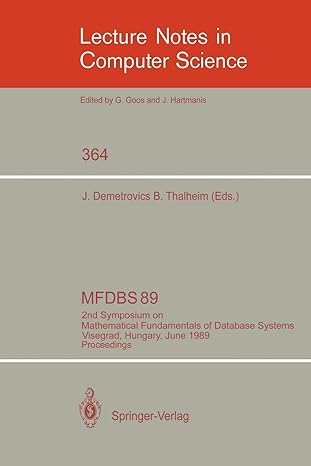Answered step by step
Verified Expert Solution
Question
1 Approved Answer
Machine Learning with the mtcars Dataset Objectives: Perform data preprocessing on the mtcars dataset. Build and evaluate multiple regression models to predict a suitable target
Machine Learning with the mtcars Dataset
Objectives:
Perform data preprocessing on the mtcars dataset.
Build and evaluate multiple regression models to predict a suitable target variable.
Discuss challenges and considerations when using a small dataset.
Instructions:
Load the mtcars dataset:
This is a built in dataset
Explore the data:
Summarize key statistics, identify missing values if any and visualize distributions of variables.
Choose a suitable target variable for regression eg mpg horsepower, weight You can try to use varaible other than MPG
Preprocess the data:
Handle missing values if present using appropriate techniques like imputation or removal.
Consider outlier treatment if necessary.
Create binary features from categorical variables if applicable
Split the data:
Split the data into training and testing sets using an appropriate ratio eg
Consider using stratified sampling if your target variable is categorical.
Scale the features:
Scale the features to ensure each variable has equal importance in the models.
Build and evaluate models:
Build and evaluate at all five different regression models we learned in class eg linear regression, Polynomial Regression, SVR Decision Tree and Random forest
Consider hyperparameter tuning for models that benefit from it eg SVR random forest
Use appropriate metrics for evaluation eg mean squared error, Rsquared, adjusted Rsquared
Create visualizations to compare model performance eg scatter plots, residual plots
Discuss challenges and considerations:
Discuss the limitations of using a small dataset like mtcars for regression.
Explain potential challenges you encountered eg overfitting, limited feature selection
Suggest potential techniques to mitigate these challenges eg crossvalidation, regularization
Conclusion:
Summarize your findings and recommend the best models for predicting the chosen target variable in mtcars.
Discuss the generalizability of your results and potential further research directions.
Write a report on your findings, including your recommendations on which models to use for predicting your chosen dependent variable.
Deliverables:
R Code as R or RMD file
Also a Report explaining the following:
Clear Introduction:
State the Problem: Begin with a clear statement of the problem you are addressing in your analysis.
Objective: Clearly state the objective or what you intend to achieve through your analysis.
Scope: Define the scope of your analysis. What is included and what is not?
Data Preprocessing:
Data Cleaning: Describe how you handled missing data, outliers, or errors in your dataset. Be clear about your approach.
Data Transformation: Explain any transformations performed on the data, such as normalization or encoding categorical variables.
Feature Engineering: If you created new features, explain why and how they are useful.
Model Building:
Model Selection: Justify your choice of modeling techniques. Explain why you chose a particular algorithm.
Hyperparameter Tuning: Describe any hyperparameter tuning and why it was necessary.
Training and Testing: Explain how you divided the data into training and testing sets.
Model Evaluation:
Performance Metrics: Clearly define and interpret the performance metrics you used eg accuracy, precision, recall, Fscore
Visualizations: Use visualizations, like ROC curves, to illustrate model performance.
Comparison: Compare the results of different models or approaches, if applicable.
Results Interpretation:
Explain Findings: Interpret the results. What do the numbers mean in the context of the problem?
Provide Insights: Share insights that you gained from your analysis.
Recommendations:
Recommendations: Offer practical recommendations based on your findings. What should stakeholders do in response to your analysis?
Clear Conclusion:
Summary: Summarize the key findings of your analysis.
Conclusion: Provide a clear and concise conclusion, reiterating the problem, the findings, and their significance.
Future Work: Suggest areas for further exploration or improvements to your analysis.
Clarity and Organization:
Structure: Organize your report logically with clear headings and subheadings.
Use of Code: While it's okay to include code snippets, keep them separate in an appendix. Do not clutter the main report with code.
Visual Aids: Use figures, tables, and visual aids to make complex concepts more understandable.
Language and Style:
Concise Language: Keep your writing clear, concise, and to the point.
Avoid Jargon: Define any technical terms or jargon you use.
Proofreading: Proofread your report for grammar and spelling errors.
Step by Step Solution
There are 3 Steps involved in it
Step: 1

Get Instant Access to Expert-Tailored Solutions
See step-by-step solutions with expert insights and AI powered tools for academic success
Step: 2

Step: 3

Ace Your Homework with AI
Get the answers you need in no time with our AI-driven, step-by-step assistance
Get Started


